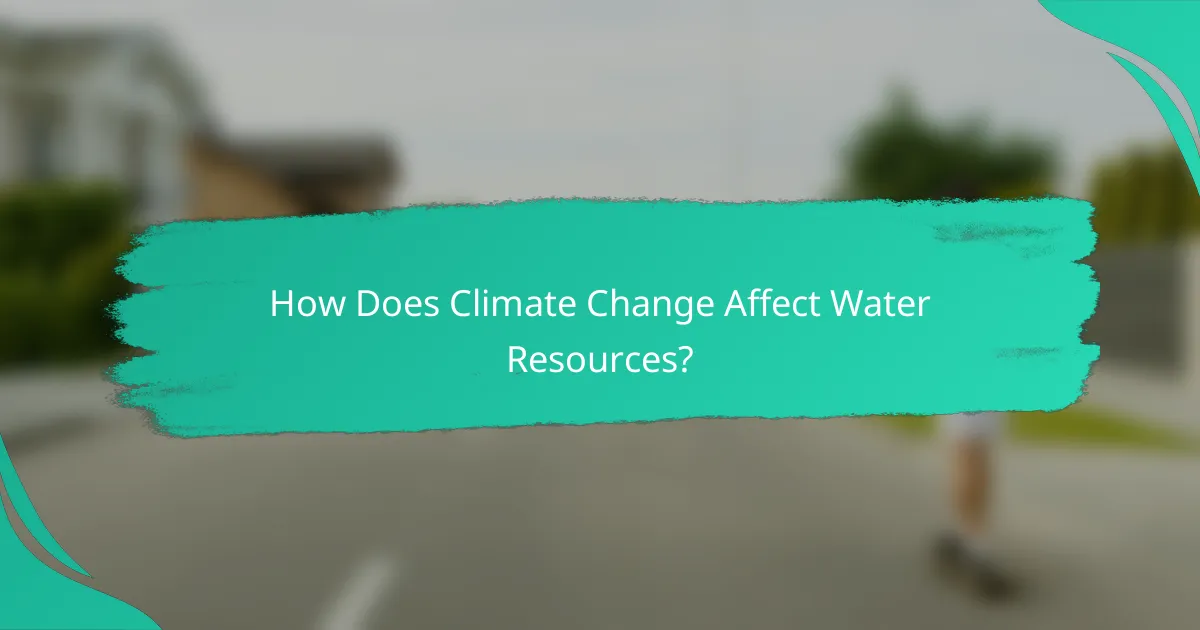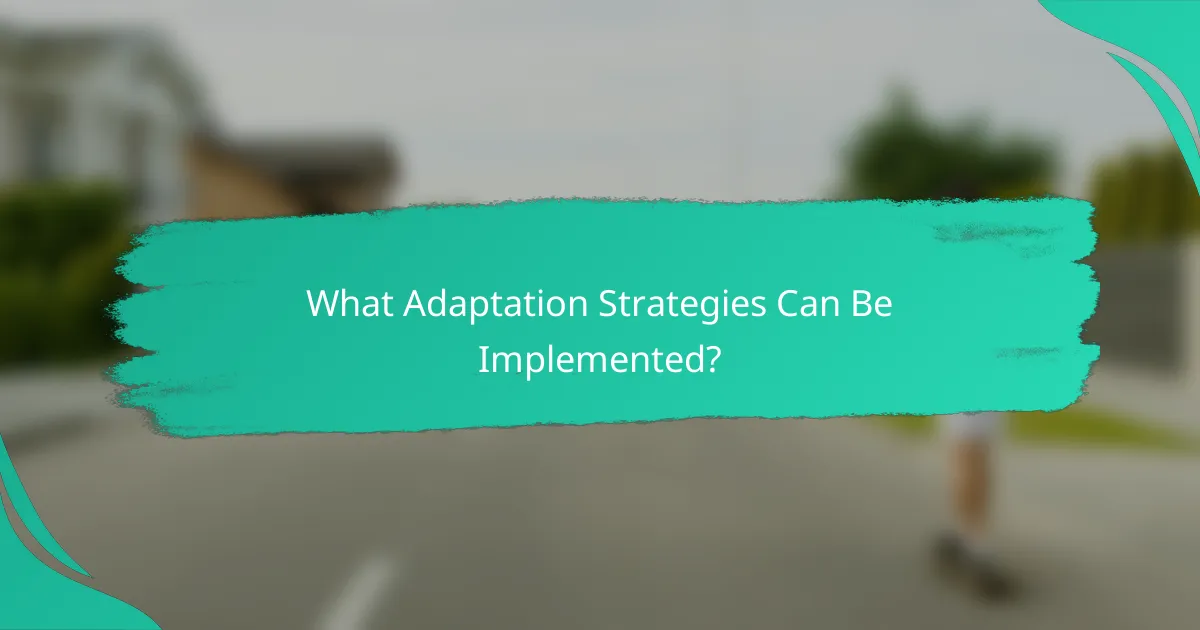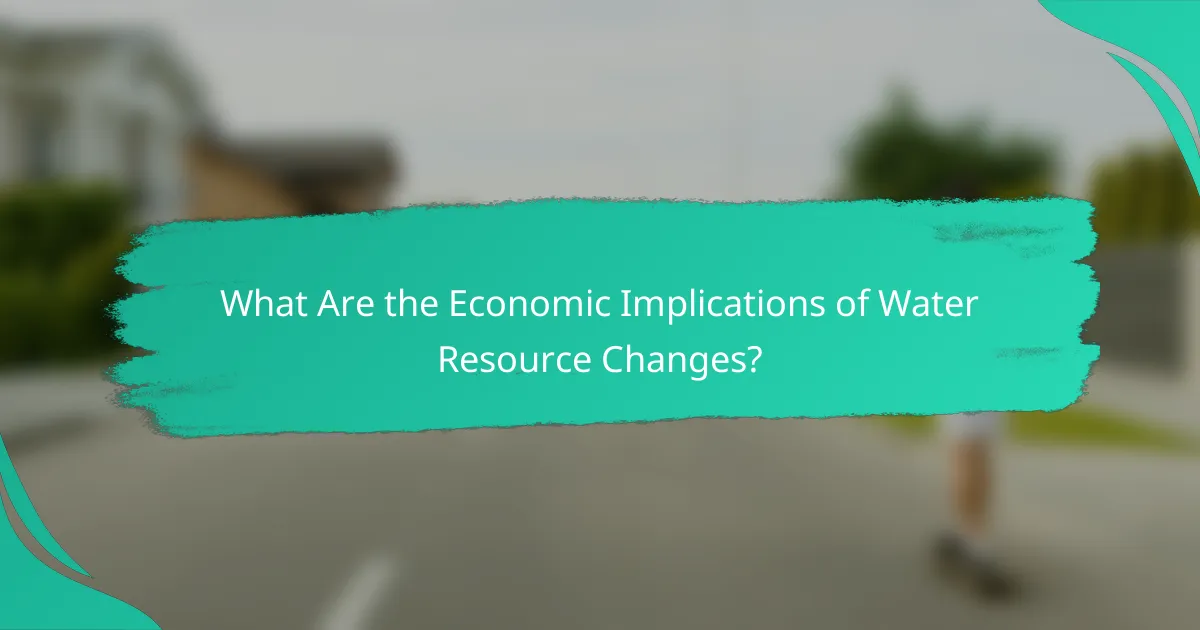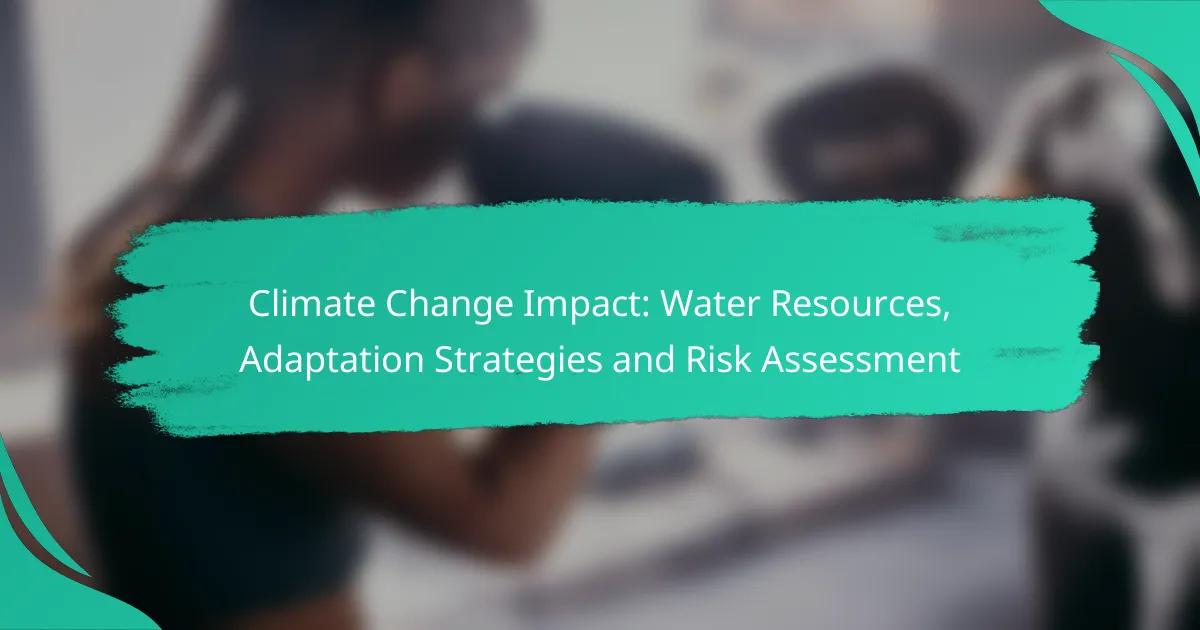Climate change poses significant challenges to water resources, affecting both their availability and quality. As droughts become more frequent and precipitation patterns shift, effective management and adaptation strategies are essential to ensure sustainable water use. Implementing comprehensive risk assessments can help identify vulnerabilities and prioritize responses, fostering resilience in communities facing these environmental changes.

How Does Climate Change Affect Water Resources?
Climate change significantly impacts water resources by altering the availability and quality of freshwater. These changes can lead to increased droughts, shifts in precipitation, and deterioration of water quality, all of which pose challenges for water management and sustainability.
Increased drought frequency
Climate change leads to more frequent and severe droughts, particularly in regions already prone to water scarcity. This increased drought frequency can reduce surface water and groundwater supplies, making it difficult for agriculture and communities to access the water they need.
To adapt, regions facing heightened drought risk should implement water conservation practices, such as rainwater harvesting and efficient irrigation systems. These strategies can help mitigate the impact of reduced water availability.
Altered precipitation patterns
Changes in climate result in altered precipitation patterns, with some areas experiencing heavier rainfall and others facing significant reductions. These shifts can disrupt water supply systems and lead to flooding or water shortages.
Regions should invest in infrastructure improvements to manage stormwater effectively and enhance water storage capacity. Adapting to these patterns requires flexible water management strategies that can respond to changing conditions.
Impact on freshwater availability
Freshwater availability is directly affected by climate change, as melting glaciers and altered river flows can reduce the amount of water accessible for human use. This is particularly critical in areas dependent on glacial melt for their water supply.
To address these challenges, communities should explore alternative water sources, such as desalination or wastewater recycling, to supplement their freshwater supplies. Planning for future water needs is essential to ensure sustainable access.
Effects on water quality
Climate change can negatively impact water quality through increased temperatures and altered runoff patterns, which may lead to higher concentrations of pollutants and pathogens. Warmer waters can also promote harmful algal blooms, further degrading water quality.
Regular monitoring of water sources is crucial to identify and address quality issues promptly. Implementing best management practices in agriculture and urban areas can help reduce runoff and protect water quality.
Changes in water temperature
Rising air temperatures due to climate change lead to increased water temperatures in lakes, rivers, and reservoirs. Warmer water can affect aquatic ecosystems, leading to shifts in species composition and reduced oxygen levels.
To mitigate these effects, it is important to maintain riparian buffers that provide shade and cool water temperatures. Additionally, managing water withdrawals during hot periods can help protect aquatic habitats and maintain ecosystem health.

What Adaptation Strategies Can Be Implemented?
Adaptation strategies for climate change focus on managing water resources effectively to mitigate impacts. These strategies include various techniques that conserve water, improve infrastructure, modify policies, and engage communities.
Water conservation techniques
Water conservation techniques are essential for reducing water usage and ensuring sustainable supplies. Simple methods include installing low-flow fixtures, rainwater harvesting systems, and drought-resistant landscaping.
Implementing these techniques can lead to significant water savings, often reducing consumption by 20-50%. Regular monitoring and maintenance of these systems are crucial to maximize their effectiveness.
Infrastructure improvements
Upgrading water infrastructure is vital for enhancing resilience against climate impacts. This can involve repairing aging pipes, improving stormwater management systems, and constructing new reservoirs to capture excess rainfall.
Investing in smart technologies, such as automated leak detection systems, can also help reduce water loss. These improvements can require substantial funding, but they often yield long-term savings and increased reliability.
Policy and regulatory changes
Policy and regulatory changes play a critical role in managing water resources effectively. Governments can implement stricter water usage regulations, incentivize conservation practices, and promote sustainable land use planning.
Collaboration between local, state, and federal agencies is essential to create cohesive policies. Engaging stakeholders in the policy-making process can enhance acceptance and compliance.
Community engagement initiatives
Community engagement initiatives foster local involvement in water management strategies. Educational programs can raise awareness about water conservation and the impacts of climate change on local resources.
Organizing community events, such as clean-up days or water-saving challenges, can encourage participation and build a sense of ownership. Strong community ties can lead to more effective implementation of adaptation strategies.

How Can Risk Assessment Be Conducted?
Risk assessment can be conducted through a systematic process that identifies potential hazards, evaluates their impacts, and prioritizes responses. This involves gathering data, analyzing vulnerabilities, and engaging stakeholders to ensure comprehensive understanding and action.
Identifying vulnerable regions
Identifying vulnerable regions is a critical first step in risk assessment. This involves mapping areas that are susceptible to climate change impacts, such as flooding, drought, or water scarcity. Factors like geography, population density, and existing infrastructure should be considered to pinpoint regions at highest risk.
For example, coastal areas may be more vulnerable to rising sea levels, while arid regions could face increased drought frequency. Local data, such as historical weather patterns and socioeconomic factors, can enhance the accuracy of vulnerability assessments.
Quantifying potential impacts
Quantifying potential impacts involves estimating the severity and likelihood of adverse effects from climate change on water resources. This can include assessing changes in water availability, quality, and ecosystem health. Utilizing historical data alongside projections can help create a clearer picture of future scenarios.
For instance, a region may experience a 20-30% reduction in freshwater availability during severe droughts. Understanding these potential impacts allows for better planning and resource allocation to mitigate risks.
Utilizing climate models
Utilizing climate models is essential for projecting future climate scenarios and their potential impacts on water resources. These models simulate various climatic conditions and help predict changes in precipitation patterns, temperature, and extreme weather events.
When selecting models, consider their resolution and the specific regional factors they account for. For example, regional climate models may provide more accurate forecasts for local water resource management than global models.
Stakeholder involvement
Stakeholder involvement is crucial for effective risk assessment and adaptation strategies. Engaging local communities, government agencies, and businesses ensures diverse perspectives and expertise are included in the assessment process. This collaboration can lead to more comprehensive and accepted solutions.
Organizing workshops or forums can facilitate dialogue among stakeholders, allowing for the sharing of knowledge and resources. Additionally, involving stakeholders in decision-making processes can enhance the implementation of adaptation strategies, making them more effective and sustainable.

What Are the Economic Implications of Water Resource Changes?
Changes in water resources significantly affect economies by altering costs, productivity, and overall sustainability. Water scarcity can lead to increased expenses for households and businesses, impacting economic growth and stability.
Cost of water scarcity
Water scarcity drives up costs for both individuals and industries. Households may face higher water bills as supply diminishes, while businesses often incur additional expenses for sourcing alternative water supplies or investing in water-saving technologies.
In regions experiencing severe water shortages, the economic burden can escalate quickly, with costs potentially rising by tens of percent over a few years. This can lead to increased prices for goods and services, affecting overall consumer spending.
Impact on agriculture
Agriculture heavily relies on consistent water availability, and changes in water resources can drastically affect crop yields. Farmers may need to invest in irrigation systems or drought-resistant crops, which can be costly and time-consuming.
In areas where water scarcity is prevalent, crop production may decline, leading to higher food prices and reduced food security. For instance, regions in Southern Europe have seen significant shifts in agricultural output due to changing rainfall patterns and water availability.
Effects on industry
Industries that depend on water for production, such as manufacturing and energy, face substantial risks from water resource changes. Increased water costs can lead to higher production expenses, which may be passed on to consumers.
Additionally, industries may need to adapt by implementing water-efficient processes or technologies, which can require significant upfront investment. Failure to adapt can result in reduced competitiveness and potential job losses in water-intensive sectors.
